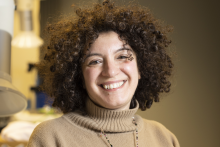Personal professorship is not new, but the faculty of Science & Technology has made it its `explicit policy', to stimulate promising young researchers every couple of years. The first ones to be appointed were Hans Hilgenkamp (38) and Harold Zandvliet (41). Simultaneously Jurriaan Huskens (37) was appointed as regular professor.
Personal professors can determine the direction of their own research and direct PhD students. Bliek: `The difference with ordinary professors is that they operate under the wings of an existing research chair. They do not have a lab of their own and therefore do not need to concern themselves with the management and financing of that lab. They get more scientific breathing space.'
The young professors get five years to prove themselves. `If during that time they do not show that they are up to it, they return to being a senior university lecturer (UHD) and lose their right to accept PhD students,' Bliek explains. This system is milder than the similar tenure tracks in America, where young researchers are given a chance to prove themselves as associate professors and fight for a permanent appointment, but are quickly fired if they fail.
The faculty hopes the personal professorship will make a career in science more attractive, but, most of all, it hopes to challenge researchers. `It is a big step from UHD to professor. This gives them the opportunity to develop and establish themselves, independently from a professor.' Bliek assures us that the policy was not developed to bind good people to the faculty. `That is not the primary goal. In fact, the question is whether this is the way to do it. You also put these people in the spotlight, make them more well-known in the academic world.'
Several professors in one research group, is that not asking for trouble? Bliek: `Obviously, they will have to be able to work well with each other. The primary chair holders have been asked to advise on the issue. They were all very supportive.'
The three new professors were appointed in subfields of nanotechnology: Condensed Matter Physics and Devices (Hilgenkamp), Physical Aspects of Nano-electronics (Zandvliet) and Nanofabrication (Huskens).
Trans. Jeroen Latour







